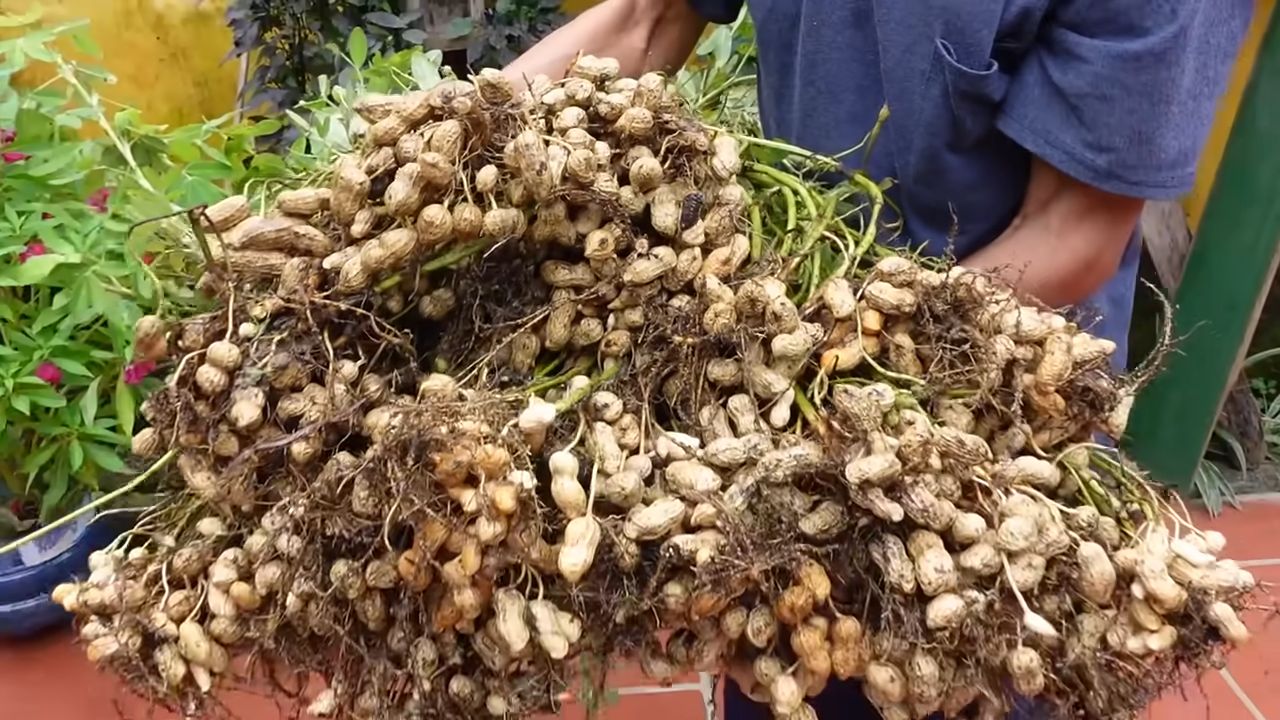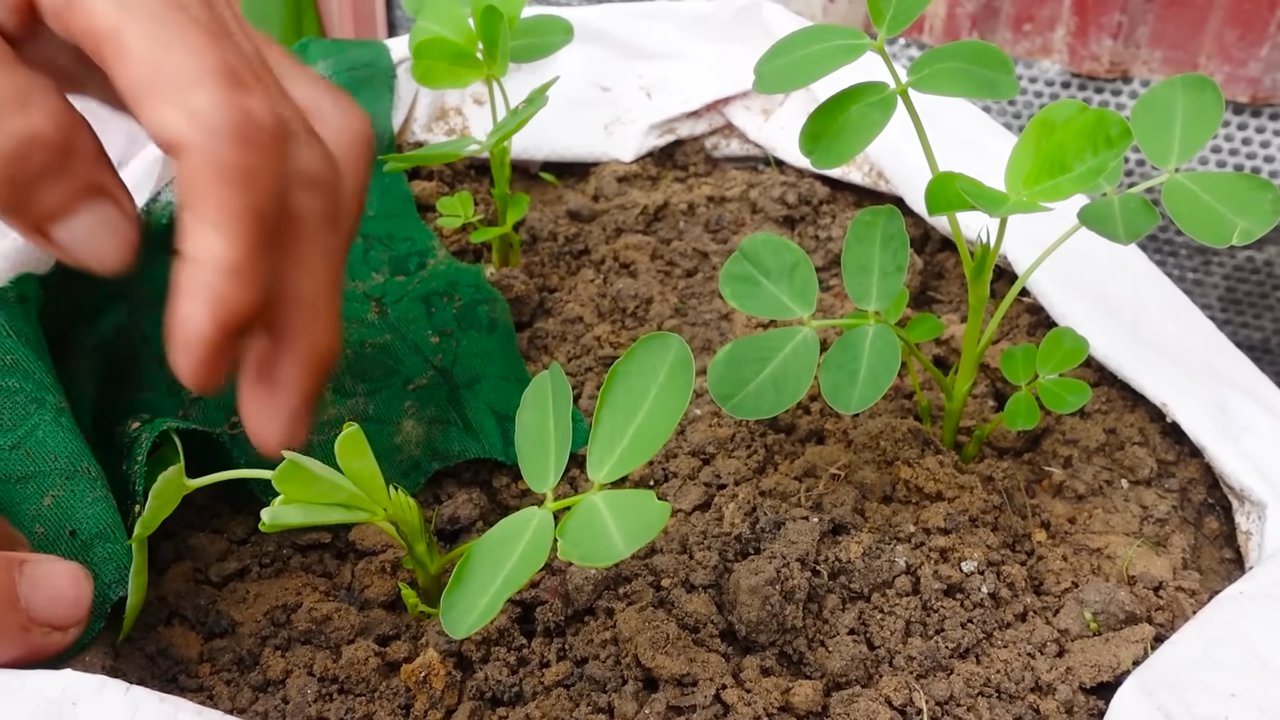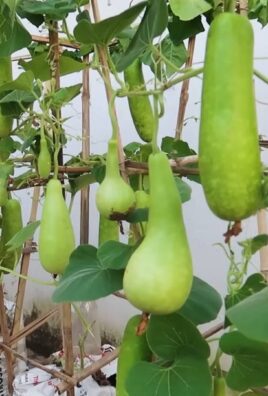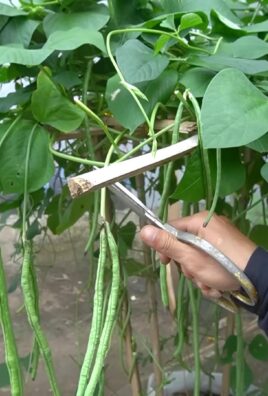Growing Peanuts at Home might sound like a whimsical dream, conjured from childhood memories of baseball games and salty snacks. But I’m here to tell you, it’s a surprisingly achievable and rewarding gardening project! Forget trekking to the store for your peanut fix; imagine harvesting your own homegrown bounty, bursting with fresh, earthy flavor.
Peanuts, despite their name, aren’t actually nuts! They’re legumes, relatives of beans and peas. Their cultivation dates back thousands of years in South America, where they were revered as a vital food source and even used in religious ceremonies. From ancient civilizations to modern-day snack aisles, the humble peanut has a rich and fascinating history.
Why should you try growing peanuts at home? Well, for starters, it’s incredibly satisfying to nurture a plant from seed to harvest. Plus, homegrown peanuts often taste better than store-bought ones, as they haven’t been sitting on shelves for weeks. But more importantly, in a world increasingly concerned with food security and sustainability, knowing how to grow your own food, even something as seemingly simple as peanuts, empowers you to become more self-sufficient. This DIY guide will provide you with all the tricks and hacks you need to successfully cultivate these delightful legumes in your own backyard, balcony, or even a container on your patio. Let’s get digging!

Growing Peanuts at Home: From Seed to Snack!
Hey there, fellow gardening enthusiasts! Ever thought about growing your own peanuts? It’s surprisingly easy and incredibly rewarding. Imagine the satisfaction of harvesting your own homegrown snacks! I’m going to walk you through the whole process, from choosing the right peanuts to enjoying your delicious harvest. Let’s get started!
Choosing Your Peanut Variety
Before we dive into planting, let’s talk about peanut varieties. Not all peanuts are created equal, and some are better suited for home gardens than others. Here’s a quick rundown:
* Virginia Peanuts: These are the large, often roasted-in-the-shell peanuts you see at ballgames. They need a longer growing season (120-130 days), so they’re best for warmer climates.
* Spanish Peanuts: These are smaller, with reddish-brown skins. They have a slightly nutty flavor and mature faster (around 100 days), making them a good choice for cooler regions.
* Runner Peanuts: These are the most commonly grown peanuts in the US, often used for peanut butter. They have a good yield and mature in about 120 days.
* Valencia Peanuts: These are sweet and have three or four kernels per shell. They mature in about 90-110 days and are great for boiling.
My recommendation? If you’re a beginner, go with Spanish or Valencia peanuts. They’re more forgiving and have a shorter growing season.
Preparing Your Peanut Planting Site
Peanuts need plenty of sunshine and well-drained soil. Here’s how to get your garden ready:
* Sunlight: Peanuts need at least 6-8 hours of direct sunlight per day. Choose a spot in your garden that gets plenty of sun.
* Soil: Peanuts prefer loose, sandy loam soil. Heavy clay soil can hinder pod development. If you have clay soil, amend it with plenty of compost and sand to improve drainage.
* Soil pH: Peanuts thrive in slightly acidic soil, with a pH between 6.0 and 6.5. You can test your soil pH with a home testing kit or send a sample to your local agricultural extension office.
* Fertilizer: Avoid using high-nitrogen fertilizers, as they can promote leafy growth at the expense of pod production. Instead, opt for a fertilizer that’s higher in phosphorus and potassium. Bone meal is a great option!
Planting Your Peanuts
Now for the fun part! Here’s how to plant your peanuts:
1. Choose Your Seeds: You can use raw, unsalted peanuts from the grocery store as seeds. Make sure they are unroasted! I usually buy a bag of raw peanuts and select the plumpest, healthiest-looking ones.
2. Soak the Seeds (Optional): Soaking the peanuts in water for a few hours (or overnight) can help speed up germination. I usually skip this step, but it can be helpful if you’re in a hurry.
3. Planting Time: Wait until the soil has warmed up to at least 65°F (18°C) before planting. This is usually a couple of weeks after the last frost.
4. Planting Depth: Plant the peanuts about 1-2 inches deep and 6-8 inches apart in rows that are 2-3 feet apart.
5. Watering: Water the peanuts thoroughly after planting. Keep the soil consistently moist, but not waterlogged, until the seedlings emerge.
Caring for Your Peanut Plants
Peanuts are relatively low-maintenance, but here are a few things to keep in mind:
* Watering: Water regularly, especially during dry spells. Peanuts need about 1 inch of water per week.
* Weeding: Keep the area around your peanut plants free of weeds. Weeds can compete with the peanuts for nutrients and water.
* Hilling: About a month after the plants emerge, hill the soil around the base of the plants. This helps to support the developing pods.
* Calcium: Peanuts need calcium to develop properly. If your soil is deficient in calcium, you can add gypsum to the soil.
* Pests and Diseases: Peanuts are generally pest-resistant, but watch out for aphids and spider mites. You can control these pests with insecticidal soap or neem oil. Leaf spot is a common fungal disease that can affect peanuts. Prevent it by providing good air circulation and avoiding overhead watering.
The “Pegging” Process: Nature’s Magic
This is where things get really interesting! After the peanut plants flower, they develop “pegs” – small, stem-like structures that grow downwards from the base of the flower. These pegs burrow into the soil and develop into peanut pods.
Important Tip: Avoid disturbing the soil around the plants during the pegging process. You don’t want to damage the developing pods.
Harvesting Your Peanuts
The moment we’ve all been waiting for! Here’s how to harvest your peanuts:
1. Timing: The best time to harvest peanuts is when the leaves start to turn yellow and the plants begin to die back. This is usually about 120-150 days after planting, depending on the variety.
2. Digging: Use a garden fork or shovel to carefully dig up the peanut plants. Be gentle, as you don’t want to break off the pods.
3. Shaking: Shake off as much soil as possible from the plants.
4. Curing: Hang the peanut plants upside down in a well-ventilated area for 2-4 weeks to cure. This allows the peanuts to dry out and develop their flavor. I usually hang them in my garage.
5. Threshing: Once the peanuts are cured, you can remove them from the plants. This is called threshing. You can do this by hand or use a peanut thresher (if you’re serious about peanut farming!).
Storing Your Peanuts
Proper storage is key to keeping your peanuts fresh and delicious.
* In-Shell Peanuts: Store in-shell peanuts in a cool, dry place, such as a pantry or refrigerator. They can last for several months.
* Shelled Peanuts: Store shelled peanuts in an airtight container in the refrigerator or freezer. They can last for several weeks in the refrigerator and several months in the freezer.
Enjoying Your Homegrown Peanuts
Now for the best part – eating your homegrown peanuts! Here are a few ideas:
* Roasted Peanuts: Roast the peanuts in the oven at 350°F (175°C) for 15-20 minutes, or until they’re golden brown and fragrant.
* Boiled Peanuts: Boil the peanuts in salted water for 2-3 hours, or until they’re soft and tender. This is a Southern delicacy!
* Peanut Butter: Make your own peanut butter by grinding the roasted peanuts in a food processor. Add a little salt and honey to taste.
* Snacking: Simply enjoy them raw or roasted as a healthy and delicious snack.
Troubleshooting Common Peanut Problems
Even with the best care, you might encounter a few challenges. Here are some common problems and how to address them:
* Poor Germination: If your peanuts aren’t germinating, make sure the soil is warm enough and that you’re not overwatering.
* Yellowing Leaves: Yellowing leaves can be a sign of nutrient deficiency. Test your soil and amend it with the appropriate fertilizer.
* Small Pods: Small pods can be caused by a lack of calcium or water. Add gypsum to the soil and water regularly.
* Pest Infestations: Keep an eye out for pests like aphids and spider mites. Treat them with insecticidal soap or neem oil.
Extra Tips for Peanut Growing Success
Here are a few extra tips to help you grow the best peanuts possible:
* Rotate Your Crops: Avoid planting peanuts in the same spot year after year. Crop rotation helps to prevent soilborne diseases.
* Use a Cover Crop: Plant a cover crop, such as rye or oats, in the fall to improve soil health.
* Mulch: Mulch around your peanut plants to help retain moisture and suppress weeds.
* Observe Your Plants: Pay attention to your peanut plants and address any problems as soon as they arise.
Growing peanuts at home is a fun and rewarding experience. With a little bit of planning and care, you can enjoy a bountiful harvest of homegrown snacks. So, get out there and start planting! I know you can do it! Happy gardening!

Conclusion
So, there you have it! Growing peanuts at home is not only achievable, but it’s also a deeply rewarding experience. From the initial thrill of planting those unassuming seeds to the satisfaction of harvesting your very own homegrown crop, the entire process is a testament to the wonders of nature and the simple joys of gardening.
Why is this DIY trick a must-try? Because it connects you to your food in a way that simply buying peanuts from the store never could. You’ll witness firsthand the fascinating life cycle of the peanut plant, from its delicate yellow flowers to the underground formation of those delicious, protein-packed nuts. It’s an educational experience for the whole family, a sustainable practice that reduces your reliance on commercially grown produce, and a fun hobby that gets you outdoors and connected to the earth. Plus, the taste of freshly harvested, homegrown peanuts is simply unparalleled – sweeter, nuttier, and bursting with flavor that you won’t find anywhere else.
But the adventure doesn’t stop there! Feel free to experiment with different varieties of peanuts to discover your personal favorite. Virginia peanuts, known for their large size, are perfect for roasting. Spanish peanuts, with their reddish skins, offer a sweeter flavor. And Runner peanuts, commonly used in peanut butter, are a versatile choice for all your peanut-related culinary creations.
Consider also exploring different growing methods. While we’ve focused on growing peanuts in the ground, you can also successfully cultivate them in containers, making it a viable option even for those with limited space. Just be sure to choose a large container with good drainage and provide ample sunlight.
And don’t forget the possibilities for using your homegrown peanuts! Beyond simply roasting and enjoying them as a snack, you can use them to make your own homemade peanut butter (a truly rewarding experience!), add them to salads for a crunchy texture, or incorporate them into your favorite Asian-inspired dishes. The possibilities are endless!
We wholeheartedly encourage you to give this DIY trick a try. It’s a relatively low-maintenance project that yields a surprisingly bountiful harvest. Imagine the pride and satisfaction of sharing your homegrown peanuts with friends and family, knowing that you nurtured them from seed to table.
Once you’ve embarked on your peanut-growing journey, we’d love to hear about your experiences! Share your tips, tricks, and triumphs in the comments below. Let’s create a community of peanut-growing enthusiasts and inspire others to discover the joys of this rewarding hobby. Did you encounter any challenges? What varieties did you try? What delicious recipes did you create with your homegrown peanuts? Your insights will be invaluable to other aspiring peanut farmers. So, get your hands dirty, embrace the challenge, and prepare to be amazed by the magic of growing peanuts at home! This is more than just a gardening project; it’s a connection to nature, a celebration of homegrown goodness, and a truly unforgettable experience.
Frequently Asked Questions (FAQ)
Q: How long does it take to grow peanuts?
A: The growing season for peanuts typically lasts between 120 and 150 days, depending on the variety and your local climate. You’ll want to plant your peanut seeds after the last frost in spring, when the soil temperature has warmed up to at least 65 degrees Fahrenheit. Be patient, as it takes time for the plants to mature and the peanuts to develop underground.
Q: What kind of soil is best for growing peanuts?
A: Peanuts thrive in well-drained, sandy loam soil. This type of soil allows for good aeration and drainage, which is essential for healthy root development and peanut formation. Avoid heavy clay soils, as they can become waterlogged and hinder the growth of the peanuts. If you have clay soil, you can amend it with organic matter, such as compost or peat moss, to improve its drainage and texture.
Q: How much sunlight do peanut plants need?
A: Peanut plants require at least 6-8 hours of direct sunlight per day to thrive. Choose a sunny location in your garden where your plants will receive ample sunlight throughout the growing season. If you’re growing peanuts in containers, make sure to place them in a sunny spot on your patio or balcony.
Q: How often should I water my peanut plants?
A: Water your peanut plants regularly, especially during dry periods. Aim to keep the soil consistently moist, but not waterlogged. Water deeply and thoroughly, allowing the water to penetrate down to the roots. Avoid overhead watering, as this can increase the risk of fungal diseases. A good rule of thumb is to water when the top inch of soil feels dry to the touch.
Q: Do peanut plants need fertilizer?
A: While peanuts are legumes and can fix nitrogen from the air, they still benefit from fertilization. Before planting, amend the soil with compost or well-rotted manure to provide essential nutrients. During the growing season, you can apply a balanced fertilizer, such as a 10-10-10 formula, according to the package instructions. Avoid over-fertilizing, as this can lead to excessive foliage growth at the expense of peanut production.
Q: How do I know when my peanuts are ready to harvest?
A: Determining the right time to harvest peanuts is crucial for optimal flavor and yield. The best indicator is the maturity of the pods. About 120-150 days after planting, carefully dig up a few plants and examine the pods. The pods should be plump and well-filled, with a distinct veining pattern on the shell. The inside of the shell should be dark in color. If the pods are still immature or the shells are thin and papery, wait a few more weeks before harvesting.
Q: What are some common pests and diseases that affect peanut plants?
A: Peanut plants can be susceptible to various pests and diseases, including aphids, spider mites, leaf spot, and root rot. To prevent these problems, practice good garden hygiene, such as removing weeds and debris from around your plants. Inspect your plants regularly for signs of pests or diseases, and take action promptly if you notice any problems. You can use organic pest control methods, such as insecticidal soap or neem oil, to control aphids and spider mites. To prevent fungal diseases, ensure good air circulation around your plants and avoid overhead watering.
Q: Can I grow peanuts in containers?
A: Yes, you can successfully grow peanuts in containers, making it a great option for those with limited space. Choose a large container with good drainage, at least 18 inches in diameter and 12 inches deep. Fill the container with well-draining potting mix and plant your peanut seeds according to the instructions. Place the container in a sunny location and water regularly.
Q: How do I store my harvested peanuts?
A: After harvesting your peanuts, cure them by drying them in a well-ventilated area for several weeks. Spread the peanuts out in a single layer on a screen or rack and allow them to air dry until the shells are completely dry and brittle. Once the peanuts are cured, you can store them in an airtight container in a cool, dry place. Properly stored peanuts can last for several months. You can also freeze your peanuts for longer storage.




Leave a Comment